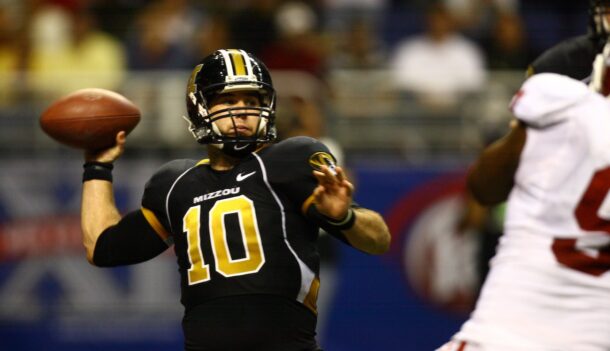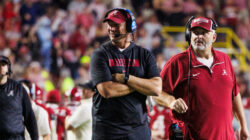
Film Study: Florida’s hiring of McElwain spells trouble for the SEC
By Murf Baldwin
Published:
Congratulations, University of Florida fans; your program has just acquired itself the next superstar coach of the Southeastern Conference in former Colorado State Rams coach Jim McElwain.
That’s no disrespect to ousted coach Will Muschamp, who is one of the preeminent defensive minds in all of football, it’s merely shedding light on the type of coach, recruiter, tactical wizard and person McElwain is.
For the record, if Muschamp were able to continue on as head coach he would’ve eventually righted the ship and restored this historic program back to its rightful place among the elite.
But coming on the heels of, perhaps, the greatest coach in the program’s history — current Ohio State coach Urban Meyer — meant that Muschamp wouldn’t be granted the necessary time to fulfill the goals that comes with a program of this magnitude.
In this day and age of instant gratification, coaches like Lou Holtz — who had a record of 13-20 in his first three seasons as a head coach — would have had a difficult time becoming the icon he is today as he would be forced back into coordinator duties relatively quickly.
But if it’s all about timing, McElwain’s arrival is like Los Angeles Lakers’ star Kobe Bryant hitting one of his patented game-winning shots, especially when you factor in how full the cupboard is, the current landscape of the eastern division and the slightly tempered expectations following Muschamp’s tenure (emphasis on slightly).
Business has just picked up in Gainesville, and the returns on the investment should come immediately in more aspects than people realize.
– – – – – – – – – – –
As someone who covers the University of Alabama, predominantly, I’m very versed in what Coach McElwain brings to the table. His time spent at the Capstone is indelible in my mind for the brand of football he brought to the table.
From 2008 to 2011 (and currently), Bama showed the ability to be as physical as anyone in the country behind a dominant offensive line and a host of superstar running backs: Glen Coffee, Mark Ingram, Trent Richardson and Eddie Lacy.
But make no mistake about it; Bama won plenty of games on the strength of its passing attacks — despite the lack of a big-time quarterback talent for the majority of McElwain’s tenure.
That’s not to say that John Parker-Wilson and Greg McElroy weren’t good quarterbacks, they just weren’t the type of quarterbacks that could consistently put a team on their back like, say, former Gators’ star Tim Tebow.
It’s widely known that Muschamp’s failures stemmed from his inability to truly establish an offensive identity, or find a competent signal-caller for his ground-and-pound approach.
His initial season saw the combination of offensive coordinator Charlie Weis and QB John Brantley front one of the most incompetent offensive attacks in Gator history. As the famed offensive coordinator for the New England Patriots during their dynasty years, 2000-04, the personnel simply didn’t mesh with Weis’ philosophy.
Prior to accepting the Florida job, Weis was the OC for a surprise Kansas City Chiefs team that lead the NFL in rushing behind outside/inside stylings of Jamaal Charles (1,467 yards) and Thomas Jones (896). But it was the play of QB Matt Cassel (27 TDs, 7 INTs) that brought the entire operation together.
And when you consider that Cassel managed just 16 TDs and 16 INTs the previous season before Weis, you can plainly see why Gator nation expected him to bring the offense up to snuff in a rapid manner.
But Florida lacked an authentic between-the-tackles rushing attack, or a true stretch-vertical threat at the QB position for his Erhardt-Perkins offensive system. Weis didn’t give it enough time, bolting to be the head coach at the University of Kansas after one season, so Muschamp was left to find someone who had a similar approach philosophically.
The next duo to front the offense came in the form of highly touted QB Jeff Driskel and former Boise State OC Brent Pease. The latter was dealt a raw hand as the team encountered a wealth of injuries to key players throughout his two-season run.
But it was still very apparent that a pro-style approach wasn’t yielding the type of results an elite team necessitates — although the team did go 11-2 in Pease’s first season on campus (mostly due to an extremely stout defense).
Above all else, evaluators clearly missed on Driskel as he lacked the acumen to be a top-flight QB. As the No. 1-ranked signal-caller coming out of Oviedo, Fl., Driskel was billed as being a Tebow-like athlete who could perform in any type of scheme: stretch-vertical, West Coast or option-based approach.
He didn’t quite fit Pease’s scheme, so Muschamp went out and hired former Duke OC Kurt Roper this past season, only to yield similar results. Roper’s scheme, more of a college-based approach equipped with plenty of option, seemed like the one that would ultimately take Driskel to the next level.
But, quite frankly, he looked as though he should’ve undergone a position change earlier in his career. He lacked the ability to read defenses; his accuracy was extremely suspect; he was reluctant to use his god-given athleticism.
He’s been an albatross for the entire offense as he’s similar to that troubled woman that every guy thinks he can fix if they were to date; the inability to develop Driskel ultimately fell upon Muschamp as he’s the overseer of the program.
If Muschamp could’ve found some offensive consistency, Florida would’ve owned the eastern division behind its suffocating defense. But going with a heavy run-based approach won’t consistently win games (although it will beat Georgia!).
Florida needs balance; thats where McElwain comes into play…
Philosophical Match To The Recruiting Base
McElwain’s scheme is a like a mix of Weis’, Pease’s and Roper’s. Ran predominantly out of “11” and “12 personnel,” he favors the high percentage throws of the short-to-intermediate game but will not hesitate to go vertical a few times a game.
He believes in efficiency and limiting turnovers. His QB at CSU, Garrett Grayson, completed 64.8 percent of his passes for 3,779 yards with 32 TDs opposed to just 6 INTs, which was very similar to the work he had with McElroy his senior season (2,987 yards with 20 TDs and 5 INTs).
Here we see Grayson generating an explosive touchdown off a play-action fake with all verticals. Operating out of the pistol allows the QB to perform a hard fake by turning his back to the defense — which is something you don’t get out of a Shotgun formation.
Efficiency at the QB position usually is in conjunction with a highly effective rushing attack. CSU’s Dee Hart, an Alabama transfer, rushed for 1,254 yards with 16 TDs after rushing for only 166 yards in his three seasons at Bama. The season prior, Kapri Bibbs — now with the Denver Broncos — rushed for 1,741 yards with an astronomical 31 TDs!
McElwain loves to work out of the pistol formation to creates downhill running lanes from his one-back sets. When used in combination with a two-tight set, you get some serious physicality out of the single-back formation.
Case in point: Hart took this stretch play and bent it back against the grain for a nice gain. The two-tight end set adds value to the scheme’s versatility standpoint — especially when said “Y’s” are able to block as well as they catch.
Florida back Kelvin Taylor will undoubtedly be a breakout star in McElwain’s mix of zone- and man-blocking scheme runs. Expect to see him deployed a ton in outside zone as his agility, vision and speed lends itself to the scheme.
At 5’10” 209 pounds, Taylor is equally adept at running between the tackles or bending the edges. With incumbent starter Matt Jones, a 6’2″, 235-pound physical freak, already declaring his intentions to enter the NFL draft, McElwain will have to develop another star to play in concert with Taylor.
But it will be his decision at the QB position that garners the most attention. Freshman Treon Harris, 5’11”, 178 pounds, showed he had some promise when he finally got the call to take over for Driskel.
He’s a fantastic athlete who has a good arm but lacks the necessary accuracy to function in McElwain’s offense. His mechanics need a ton of work, which is something Coach Mac specializes in.
Highly touted freshman Will Grier may have a chance to win the job as McElwain prefers QBs that are able to operate from within the pocket (although he could be considered an athlete as well, he just has better size). The signal-callers in this scheme are more like caretakers than bus drivers.
Some may call it conservative, but theres no substitute for being efficient and getting the ball in the hands of your playmakers. I also wouldn’t rule out Driskel returning and getting the full-McElwain treatment and rescuing his career. (Sometimes that girl looks to good to pass up, you know?)
Receiver DeMarcus Robinson has all the tools to be elite — especially in this new scheme. He’s as fast as it gets and understands route-running concepts. But after him, it looks pretty bleak — although Latroy Pittman Jr. and Ahmad Fulwood have shown promise.
The offensive line has shown the ability to dominate in the run game, and you can bet your bottom dollar McElwain will get the most out of that unit.
While most fans, and writers, are clamoring for a high-powered passing attack to return to the Swamp, it’s balance that wins in this day and age. McElwain’s defensive hire may be the most important decision he makes, as his fingerprints will be all over the offense.
Recruits and fans will love his jovial personality — which is actually very reminiscent of Florida State head coach Jimbo Fisher (who had similar success as an OC under Saban) — but most of all they will love how effectively his team executes.
Things just got very real, folks.
Former linebacker/safety Murf Baldwin specializes in diving deep into the Xs and Os of the game with the goal of educating and entertaining while bringing fans closer to their team.









